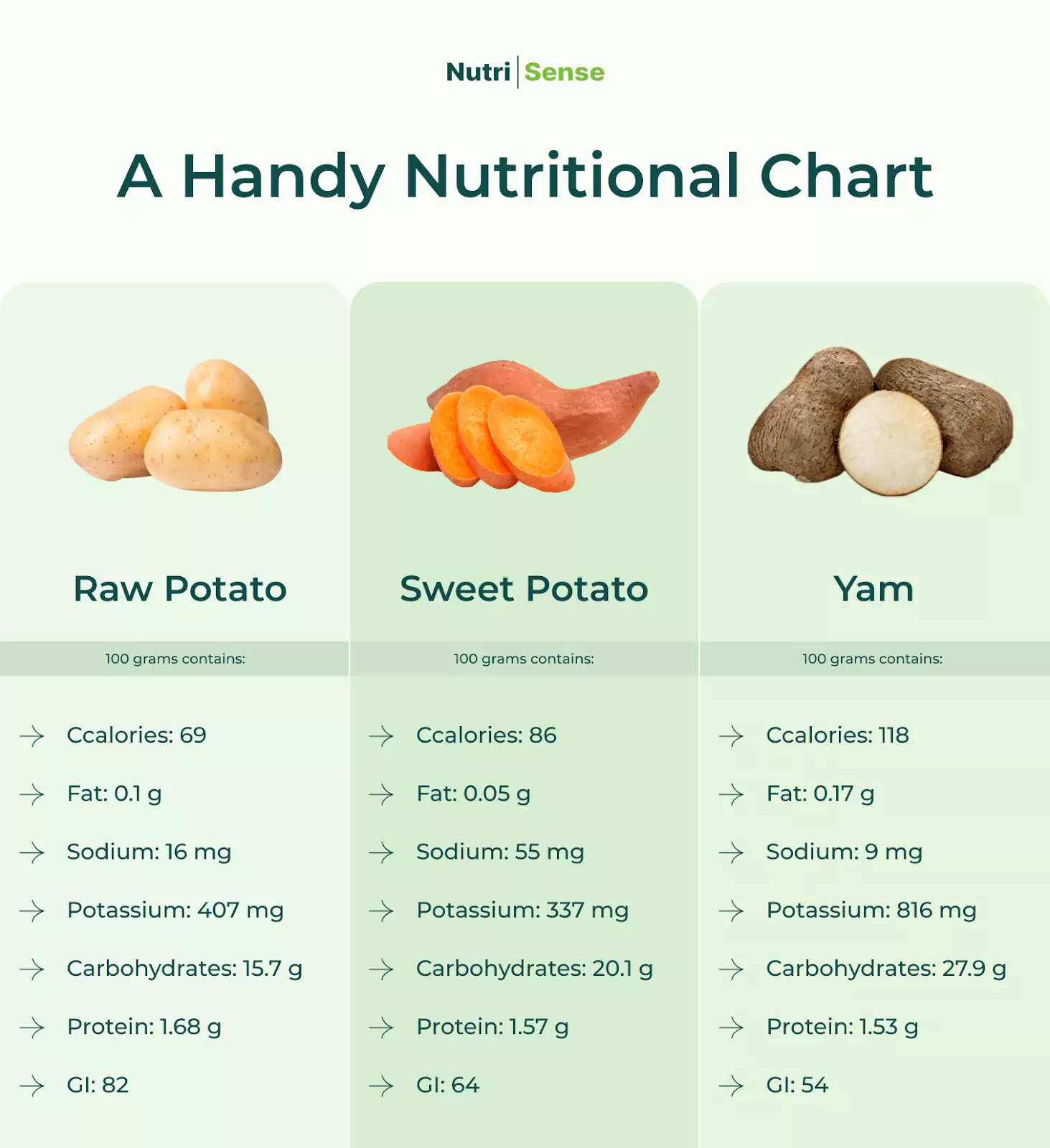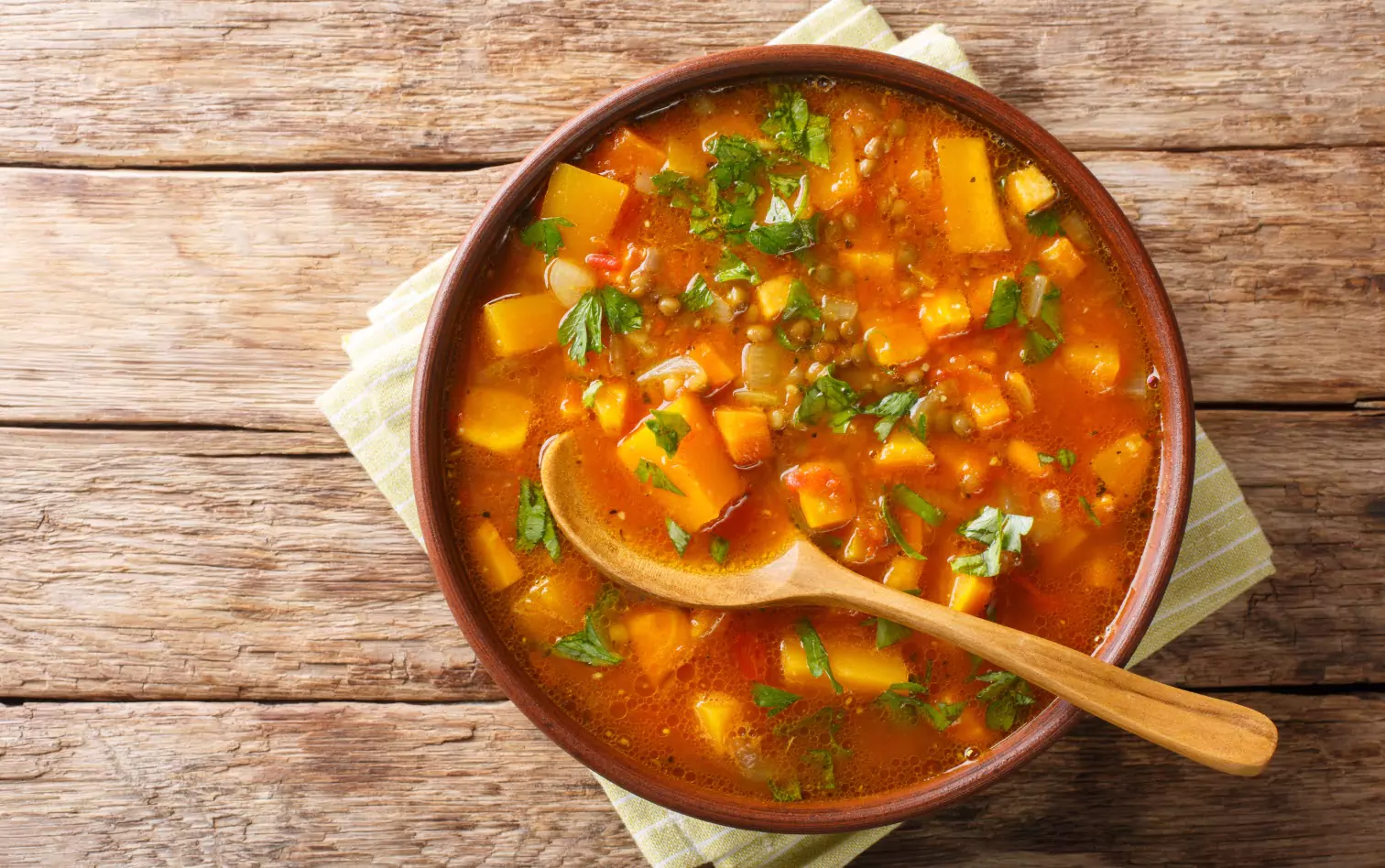
What do potatoes, yams, and sweet potatoes have in common? Apart from lending themselves well to various cooking methods, they’re all thought to be in the same family of vegetables—although this may not be entirely true.
While it’s true that potatoes, sweet potatoes, and yams are similar in usage, they’re only distantly related. Sweet potatoes are not potatoes, and though some people use yams and sweet potatoes interchangeably, they’re all different plants!
Potatoes and yams are tubers, but potatoes are a starchy food from the nightshade plant family, and yams are from the Dioscoreaceae plant family. On the other hand, sweet potatoes are from the morning glory plant family. If you don’t know what any of this means, don’t worry. We’ve got more on that below!
An interesting thing to note before we continue is that regular white potatoes are one of the most consumed vegetables in the United States. All three of these root vegetables are nutritionally and aesthetically different—and they taste different too! Still, whether we’re talking weight loss or blood glucose, the various types of potatoes haven’t always had the best reputation compared to yams and sweet potatoes.
But are sweet potatoes and yams really all that different from potatoes? Should you pick a yam over a russet potato next time you make a bowl of mash? We’re going to look at each one to see whether one is better than another for your health and how to choose and prepare them.
Potatoes

Potatoes are an incredibly versatile vegetable. They’re rich in carbohydrates, which make them both filling and a good energy source. The starchy vegetable from the nightshade family usually has brown skin and white or yellow flesh.
A single raw potato contains approximately 80 percent water and is usually full of healthy carbohydrates and nutrients. Of course, potatoes aren’t typically consumed plain, and cooking methods differ depending on the type of potato you pick and your meal planning process. They’re usually baked, boiled, or fried. The vitamin, fiber, and protein content can differ depending on how you cook them.
Prepared the right way, potatoes can be a healthy, filling addition to your diet. They’re low in fat naturally but are often prepared with high salt ingredients or fried, turning them into foods high in refined oils. Baking potatoes in the oven is usually the healthiest way to prepare them. Other methods of preparation, such as air frying, boiling, or sautéing, can also be healthy methods to consider.
The Nutrient Content and Health Benefits

While the nutrient profile will vary depending on the type of potato you pick, potatoes usually have a variety of vitamins, fiber, antioxidants, and potassium. For example, Yukon Gold and russet potatoes usually have more starch content than red potatoes. While potatoes are not a low-carb food, their carbohydrates are primarily in the form of starch. The amount differs according to type and weight—a medium white potato contains 30 grams of carbs.
Potatoes also rank relatively high on the glycemic index (GI) scale. A red potato has a glycemic index of around 80, though the GI of a potato vary greatly depending on factors like size and cooking method, often ranging between 50-100.
Vitamins and Minerals in Potatoes
- Vitamin C
- Protein
- Fiber
- Carbohydrates
- Calcium
- Potassium
- Phosphorus
- Iron
- Niacin
- Thiamin
- Riboflavin
Potatoes are not a high-fiber food, but they do contain a good amount of fiber. The fiber content can help your body regulate blood sugar levels and cholesterol. They are low in protein but can have more protein than other plants like legumes and soybeans. They also contain resistant starch, which includes the health benefits of soluble and insoluble fiber.
Because of their varied nutritional content, they may not be as bad for your health as you think! Of course, remember that the type of potato you choose to eat matters—a plate full of instant mashed potatoes or greasy French Fries may do more harm than good! As with any other food, it’s best to eat potatoes in their whole food state, as close to the source as possible.
Some of the health benefits of eating potatoes in moderation include helping to fight disease thanks to the antioxidant content. The starch and fiber help with digestive health, and the potassium content can help lower blood pressure and help with heart health. Although some studies find that potatoes may contribute to weight gain in some, they’re a satiety-inducing food. So, eating potatoes in moderation may also help some people with weight management.
Sweet Potatoes

Sweet potatoes are a root vegetable in the morning glory family. Technically, sweet potatoes are not potatoes, although they’re both starchy vegetables with similar nutrient content.
Sweet potatoes typically have brown skin and orange flesh, but some less common varieties can be white and purple. Just like their name, sweet potatoes are sweeter than potatoes.
The Nutrient Content and Health Benefits of Sweet Potatoes

Sweet potatoes are rich in vitamins, minerals, and fiber. They also contain many antioxidants that are beneficial to preventing free radical damage and chronic diseases. As a result, sweet potatoes are often called a “superfood.” They may reduce the risk of cancer, diabetes, macular degeneration, heart disease, and obesity.
Vitamins and Minerals in Sweet Potatoes
- Vitamin C
- Thiamin
- Vitamin D
- Iron
- Zinc
- Vitamin B
- Magnesium
- Calcium
- Phosphorus
- Potassium
Antioxidants found in sweet potatoes:
- Carotenoids—these are also responsible for their orange coloration
- Beta-carotene
- Anthocyanin
Like potatoes, most of the carb content of sweet potatoes comes from their starch content. They also contain simple sugars like glucose, fructose, and sucrose. They are also not a low glycemic index good, although they may not rank as high on the glycemic index scale as potatoes. Although this can vary, their GI ranks more in the medium range, around 64.
They have small amounts of resistant starch but mostly contain rapidly digestible starch—although cooking and cooling them can raise the amount of resistant starch. Unlike potatoes, sweet potatoes are relatively high in fiber. A single, medium sweet potato contains around 4 grams of fiber.
The health benefits of eating sweet potatoes in moderation include preventing a vitamin A deficiency because of the high beta-carotene content. Consumed in the right way, sweet potatoes can provide energy, nutrients, and satiety. To keep glucose steady, it's best to consume sweet potatoes with a good quality protein source. Some studies suggest sweet potatoes may also reduce your risk of cancer.
Because they have more fiber, vitamins, and a lower GI, sweet potatoes are often thought to be healthier than potatoes. However, before picking one over the other, remember that everyone’s body reacts differently to different foods. It’s a good idea to work with a registered dietitian if you’re considering making any changes to your diet and avoid adding or eliminating foods.
Yams

Yams are often labeled as sweet potatoes and vice versa, but they’re different vegetables! Apart from coming from separate plant families (Yams are part of the lily family), they also look and taste different. While sweet potatoes have soft, thin skin, yams have rough, thick skin. They are also less sweet and flavorful than sweet potatoes. Unfortunately, they’re also often mislabeled, and you may find sweet potatoes labeled as yams in some stores.
Similar to sweet potatoes and potatoes, yams have brown skin. They contain a white interior that is very starchy and have an earthy taste that isn’t as sweet as sweet potatoes but not quite as neutral as potatoes. You can think of them as hovering somewhere in between.
The Nutrient Content and Health Benefits of Yams

A popular part of alternative medicine, yams have a range of health benefits and nutrient content that get lost in all the confusion about whether they’re sweet potatoes or not. Yam extract is even in skincare products!
Here are some of the vitamins and nutrients found in yams:
- Vitamin C
- Vitamin A
- Vitamin E
- Folates
- Niacin
- Vitamin K
- Riboflavin
- Pyridoxine
- Potassium
- Phosphorus
- Protein
- Fiber
Because they contain dietary fiber that helps you feel full for longer, yams may also help with weight management goals. Like potatoes, yams are rich in potassium which has many health benefits, including reducing your risk of strokes.
Yams may also have other interesting health benefits that help them stand apart from potatoes and sweet potatoes. These benefits include their potential to help with menopausal symptoms and their effect on fertility. Some animal studies suggest a link to better glucose metabolism, although research on this is still ongoing.
Potatoes, Yams, Sweet Potatoes, and Blood Sugar

Potatoes, yams, and sweet potatoes can be a healthy part of most diets. If you struggle to maintain your blood sugar levels, you may want to be cautious when loading up on the potatoes, yams, and sweet potatoes. All three root vegetables are high in carbohydrates. If not correctly balanced with the rest of your meal or dietary needs, they can cause blood sugar spikes, which increase your risk of type 2 diabetes.
It can be helpful to monitor your blood sugar levels with a tool like a CGM, so you can see what foods affect your blood sugar levels. Depending on your unique needs, you can work with a doctor or dietitian to determine the amount and type of foods to include in your diet.
Now that you know more about each type, here’s a quick rundown on the nutritional content of potatoes, sweet potatoes and yams:

Try These Healthy Recipes
Wondering how to include these three starchy vegetables in some delicious meals? Here are three recipes we love, with some ingredient swap and alternative suggestions from our dietitian, Carlee Hayes, to help you start experimenting to see how your body responds to yams, sweet potatoes, and potatoes. Consider using a tool like a CGM and working with a registered dietitian to track how your body responds to each meal to see what works best for your specific body.
Healthy Oven Baked Potatoes From allrecipes

You’ll need:
- 1 tablespoon olive oil
- 1 tablespoon minced garlic
- 1 tablespoon chopped fresh basil
- 1 tablespoon chopped fresh rosemary
- 1 tablespoon chopped fresh parsley
- ½ teaspoon red pepper flakes
- ½ teaspoon salt
- 4 large potatoes, peeled and cubed (Pro Tip: keep the skin on for a fiber boost!)
We love this recipe because good quality oils and fresh herbs to flavor the dish. It’s also effortless to make! Pair with a side salad and your favorite protein for a complete meal!
Healthy Sweet Potato Casserole from The Modern Proper

You’ll need:
- 5 large sweet potatoes, peeled and sliced 1/8inch thick (use a mandolin if you have one!)
- 1/4 cup pumpkin seeds
- 1/4 cup candied ginger
- 1/4 cup craisins (Pro Tip: substitute this for unsweetened dried fruit such as cranberries)
- 1/2 cup pecans, chopped
- 1/4 cup maple syrup
- 1/2 cup coconut oil, melted
- 1 tsp cinnamon
- 1/4 teaspoon nutmeg
- 1 teaspoon salt
This recipe is a wonderful twist on the traditional sweet potatoes and marshmallows that we traditionally serve during the holidays. It’s still sweet but contains healthy and flavorful alternatives to the marshmallow topping. If you want to cut back even more on the sugar content, consider cutting out the maple syrup or cutting the measurement in half. Remember, sweet potatoes are naturally sweet.
African Yam Stew from Forks Over Knives

You’ll need:
- ½ cup water
- 1 onion, chopped
- 1-2 tablespoon(s) Anaheim or jalapeño pepper, minced
- 1 tablespoon ginger, ground
- 1 tablespoon garlic granules
- 2 teaspoons cumin, ground
- 2 teaspoons coriander, ground
- ¼ teaspoon crushed red pepper
- 6 yams, peeled and chopped
- 2 cups vegetable broth
- 24 ounces tomatoes, chopped
- 14 ounces garbanzo beans, drained and rinsed
- 14 ounces black-eyed peas, drained and rinsed
- ½ cup almond or peanut butter, unsweetened
- 1½ cup corn
- 6 cups collards, chopped
We love this nutrient-packed, filling meal. This recipe contains many nutrient-packed foods and is great comfort food.
Engage with Your Blood Glucose Levels with Nutrisense
Your blood sugar levels can significantly impact how your body feels and functions. That’s why stable blood glucose levels can be an important factor in supporting overall wellbeing.
With Nutrisense, you’ll be able to track your blood glucose levels over time using a CGM, so you can make lifestyle choices that support healthy living.
When you join the Nutrisense CGM program, our team of credentialed dietitians and nutritionists are available for additional support and guidance to help you reach your goals.
Ready to take the first step? Start with our quiz to see how Nutrisense can support your health.
Find the right Nutrisense programto help you discover and reach your health potential.

Carlee's training at Western Illinois University and an internship at the Memphis VA Hospital lead her to a career in outpatient counseling and bariatric nutrition therapy. In these positions, Carlee realized many of the disease states (upwards of 80%!) her patients experienced were actually preventable. She knew she had to dig deeper into preventative health and has since been passionate about helping people translate this complex glucose data into actionable changes anyone can implement into their everyday lives.




